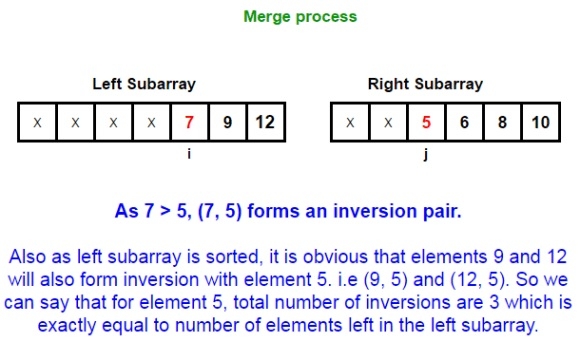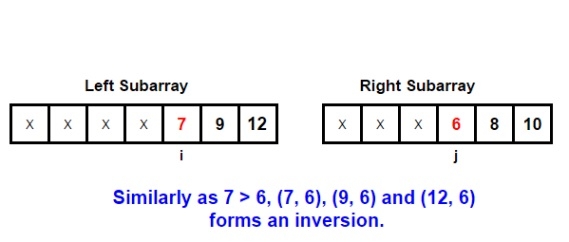
The reversal count that occurs when sorting a given array is called reversal counting. The inverse problem is a classic problem that can be solved using the merge sort algorithm. In this problem v we will count all elements to its left that are greater than it and add the count to the output. This logic is completed in the merge function of merge sort.
To understand this topic better, let us take an example. Let us consider the two sub-arrays involved in the merge process -




 ##
##
Input: arr[] = { 1, 9, 6, 4, 5} Output: Inversion count is 5
#includeint Merge(int arr[], int aux[], int low, int mid, int high) { int k = low, i = low, j = mid + 1; int inversionCount = 0; while (i <= mid && j <= high) { if (arr[i] <= arr[j]) { aux[k++] = arr[i++]; } else { aux[k++] = arr[j++]; inversionCount += (mid - i + 1); // NOTE } } while (i <= mid) aux[k++] = arr[i++]; for (int i = low; i <= high; i++) arr[i] = aux[i]; return inversionCount; } int MergeSort(int arr[], int aux[], int low, int high) { if (high == low) // if run size == 1 return 0; int mid = (low + ((high - low) >> 1)); int inversionCount = 0; inversionCount += MergeSort(arr, aux, low, mid); inversionCount += MergeSort(arr, aux, mid + 1, high); inversionCount += Merge(arr, aux, low, mid, high); return inversionCount; } int main() { int arr[] = { 1, 9, 6, 4, 5 }; int N = 5; int aux[N]; for (int i = 0; i < N; i++) aux[i] = arr[i]; printf("Inversion count is %d", MergeSort(arr, aux, 0, N - 1)); return 0; }
The above is the detailed content of C/C++ program written using merge sort algorithm to calculate reverse logarithm in an array?. For more information, please follow other related articles on the PHP Chinese website!
 What are the definitions of arrays?
What are the definitions of arrays? js string to array
js string to array Array initialization method
Array initialization method c array initialization method
c array initialization method How to find the maximum and minimum value of array elements in Java
How to find the maximum and minimum value of array elements in Java How to remove the first few elements of an array in php
How to remove the first few elements of an array in php Summary of java basic knowledge
Summary of java basic knowledge Zero-based Java self-study tutorial
Zero-based Java self-study tutorial



